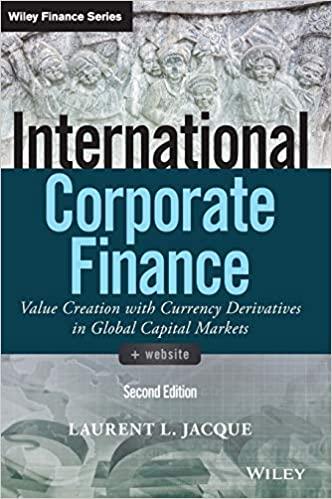On December 1, 1970, the European monetary unit (EMU) was first used as a contractual device for
Question:
On December 1, 1970, the European monetary unit (EMU) was first used as a contractual device for the denomination of a bond issue floated by the European Coal and Steel Community.
The value of the EMU was then fixed irrevocably in terms of the currencies of the six original European Economic Community (EEC) member countries for the duration of the bond issue, which had a 15-year maturity. The EMU was then defined as 3. 66 Deutsche marks (DM) or 50 Belgian francs (BF) or 3. 62 Dutch guilders (DG) or 625 Italian lira (LIT) or 50 Luxembourg francs (LF) or 5. 55 French francs (FF). At the time of bond issue, 1 EMU = 1 U.S. dollar on the basis of the then-prevailing exchange rates between the dollar and the six EEC currencies. Any subsequent devaluation or revaluation of one component currency could not alter the original relationship between the EMU and that currency. Finally, the investor had the right to choose the component currency in which payment of principal and interest were to be made by the borrowing entity.
a. Assume that a Belgium investor had purchased 25,000 EMU with a 7 percent coupon rate on December 31, 1970 (purchase of EMU-denominated bonds was made at par value). On December 17, 1971, the DM was revalued by 15 percent. Determine the interest payment received by the Belgian investor on December 31, 1971. Had the BF been devalued by 5 percent simultaneously with the revaluation of the DM, would the interest payment received by the Belgian investor be different?
b. Is the borrower protected against foreign exchange risk when denominating bonds with a multiple-currency clause such as the EMU?
c. Is the lender (bondholder) protected against foreign exchange risk when purchasing bonds that include a multiple-currency clause such as the EMU?
d. Do units of accounts that include a multiple-currency clause qualify as contractual exchange-sharing devices?
e. On December 2, 1985, the prevailing exchange rates were DM 2. 5180 =
BF 52. 10 = DG 2. 8125 = LIT 1,712 = FF 7. 6805. What was the yield to maturity (YTM) of the EMU-denominated bonds purchased by our Belgian investor?
Step by Step Answer:

International Corporate Finance Value Creation With Currency Derivatives In Global Capital Markets
ISBN: 9781119550464
2nd Edition
Authors: Laurent L. Jacque





